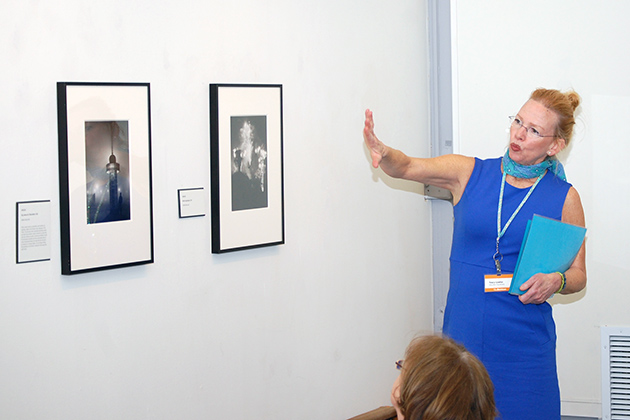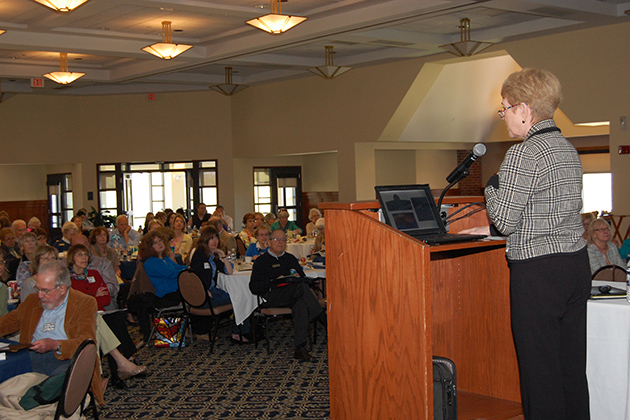
In the 17,500 museums across the United States, the individual who usually guides visitors through an educational experience about the works of art on the museum’s walls is a docent, often a volunteer trained to provide information and answer questions about art exhibitions.
“Our voice is often the only voice the visitor hears that is the museum’s voice,” says Frances Garrett, who has been involved with volunteer-managed docent programs at the Metropolitan Museum of Art in New York City. “Educational programs are being promoted as the premier way to make visitors understand and enjoy what they are seeing.”
Garrett, who did a comparative analysis on museum education programs for her master’s thesis in the Museum Studies Program at New York University, recently discussed the challenges facing museum educators as keynote speaker at the biennial Connecticut Art Docent Network Symposium, a professional development opportunity for 185 docents from museums throughout Connecticut held at The William Benton Museum of Art.

New technology provides different opportunities for teaching visitors about what they are seeing in a museum, and is a way to add to the experience of learning about art, she said, describing how the Detroit Art Institute provides an iPad to visitors as part of its education about large fresco panels created by the prominent Mexican painter Diego Rivera in tribute to the Motor City’s industries and workers.
“The world of information opens up in totally new ways with technology,” Garrett said. “Not to be afraid of technology, but to begin to think in terms of how it’s enhancing everybody’s experience in ways that we always wished would be the case. How many of us want to go back to answering machines and calling trees? The interactive computers and multi-dimensional expansion of computers give you choices of how you want to enjoy what you are learning. People are getting more comfortable entering art through multimedia.”
Garrett described a Metropolitan Museum of Art exhibit featuring a rolltop desk created by the German cabinetmaker David Roentgen that contains “nooks and crannies that move and store.” The exhibit included touch screens that demonstrated how the desk works.

She also noted the Met’s multimedia exhibition “Savage Beauty,” featuring the creations of British fashion designer Alexander McQueen, that drew large crowds to the museum.
“It had every multimedia thing I had ever experienced,” Garrett said. “It was an amazing experience. How they showed them off was mesmerizing. It took the art and exacerbated the experience. I [had] never heard of a day when the Met closed the doors because the museum was full!”
Yet despite technology, docents must also continue to develop creative presentations to connect their audience to the art, she says, by understanding how to reach each group of visitors, particularly children.
“It’s great to be young these days. We have this rich environment for kids,” Garrett said, noting that placing blank thought bubbles into a slide of the painting “Death of Socrates” by Jacques-Louis David enabled children to interact with the art. “Make the kids look at the dynamics and interactions. Ask what [those in the painting] would be thinking. They have outrageous answers.”
With a tilt toward improved marketing, museums are trying to attract a new generation of patrons and visitors by having date nights for college students that include pizza. For example, she says, the current artist-in-residence at the Metropolitan Museum of Art is Paul D. Miller, known as DJ Spooky That Subliminal Kid, who is creating a new partnership to draw new audiences to the museum.

The challenge of educating UConn students about the Benton’s exhibitions is part of the responsibility of Tracy Lawlor ’84 (SFA), education coordinator at the Benton and one of the organizers of the symposium.
“It’s amazing how many freshmen have never been to an art museum before,” Lawlor says. “When they come here they are coming with the First Year Experience program. Most of these students have not had any arts programming in their K-12 education, the result of misguided cuts from the No Child Left Behind Act. Some students become inhibited at the prospect of looking at art together and are reluctant to talk because it’s unfamiliar territory.”
One of the ways the Benton has addressed the challenge of introducing freshmen to art is with its Student Docent Program. University students are offered weekly training to learn about the art in the exhibitions and how to guide tours for other students. Like all docents at the Benton and elsewhere, they also learn the kinds of questions to ask their audience to engage them and lead them to arrive at the points that are important to appreciate about the art.
It’s a multi-layered learning experience for the student docents, Lawlor says.
“Being a docent brings great benefits for students because it builds their confidence, presentation skills, and public speaking skills,” she says. “Docents must learn how to make connections to the museum’s visitors, so they can relate aspects of the art to what they know, like pop culture for example. You want to let the audience know you care about what they think and that there are no wrong answers. It’s ok if they don’t like a work of art. If they can just develop an appreciation of art and come back on their own, that’s terrific.”
The use of technology in the Benton is a question Lawlor has posed to her students, who she says have a mixed response to the idea of using technology such as an iPad. In a group of 12 students, half said they did not like the idea, noting the museum is where they should focus on the art and think about it, while the other six said it should be used as a tool, with the docent facilitating the discussion. It was a tie.
However, a four-day program at the Benton last month may tilt the balance regarding the use of technology. The “Draw On!” event offered visitors the opportunity to sit in the shade garden patio at the Benton and draw with art supplies provided by the museum. About 400 people stopped by during the week.
“Nobody had their cell phones or laptops out. Everyone was just enjoying drawing,” Lawlor says. “There were students coming by playing acoustic guitars, contributing to the creative atmosphere. All of the students said, ‘Please do this again. This is awesome.’”



